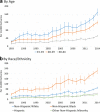Trends in Cannabis Use Disorder among Pregnant Women in the U.S., 1993-2014
- PMID: 29030807
- PMCID: PMC5834953
- DOI: 10.1007/s11606-017-4201-0
Trends in Cannabis Use Disorder among Pregnant Women in the U.S., 1993-2014
Keywords: cannabis use disorder; pregnant women; time trends.
Conflict of interest statement
Conflict of Interest
The authors declare that they do not have a conflict of interest.
Prior Presentations
None.
Figures

References
-
- Houchens R, Ross D, Elixhauser A. Using the HCUP National Inpatient Sample to estimate trends. HCUP Methods Series. Report # 2006-05. 2015; https://www.hcup-us.ahrq.gov/reports/methods/2006_05_NISTrendsReport_198.... Accessed Jan 2017.
-
- MacDorman MF, Matthews T, Declercq E. Trends in out-of-hospital births in the United States, 1990-2012. NCHS Data Brief. 2014(144):1–8. - PubMed
-
- Healthcare Cost and Utilization Project (HCUP) Administrative data: inpatient, emergency department, and ambulatory surgery care. 2016; https://www.hcup-us.ahrq.gov/news/exhibit_booth/hcup_90_min_pres.jsp. Accessed Jan 2017.
Publication types
MeSH terms
Grants and funding
LinkOut - more resources
Full Text Sources
Other Literature Sources
Medical

